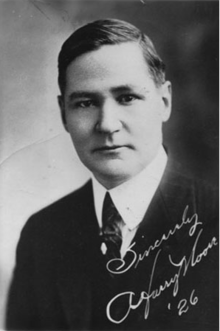1937 New Jersey gubernatorial election
The 1937 New Jersey gubernatorial election was held on November 2, 1937. Democratic nominee A. Harry Moore defeated Republican nominee Lester H. Clee with 50.84% of the vote.
| |||||||||||||||||
| |||||||||||||||||
 County Results Moore: 40–50% 50–60% 60–70% 70–80% Clee: 40–50% 50-60% 60–70% | |||||||||||||||||
| |||||||||||||||||
| Elections in New Jersey | ||||||||
|---|---|---|---|---|---|---|---|---|
 | ||||||||
|
||||||||
|
||||||||
|
|
||||||||
|
Other cities
|
||||||||
Primary elections
Primary elections were held on September 21, 1937.[1]
Democratic primary
Candidates
- A. Harry Moore, United States Senator and former Governor
Results
| Party | Candidate | Votes | % | |
|---|---|---|---|---|
| Democratic | A. Harry Moore | 295,546 | 100.00 | |
| Total votes | 295,546 | 100.00 | ||
Republican primary
Candidates
- Lester H. Clee, State Senator
- Clifford Ross Powell, State Senator
Results
| Party | Candidate | Votes | % | |
|---|---|---|---|---|
| Republican | Lester H. Clee | 249,102 | 57.20 | |
| Republican | Clifford Ross Powell | 186,386 | 42.80 | |
| Total votes | 435,488 | 100.00 | ||
General election
Candidates
Major party candidates
- A. Harry Moore, Democratic
- Lester H. Clee, Republican
Other candidates
- James E. Murray, Independent Labor
- Eugene A. Smith, National Prohibition
- Henry Jager, Socialist Party of America
- Frank Chandler, Communist Party USA
- John T. Kurzowski, Independent
- Dinshah P. Ghadiali, Independent
- John C. Butterworth, Socialist Labor Party of America
Results
| Party | Candidate | Votes | % | ± | |
|---|---|---|---|---|---|
| Democratic | A. Harry Moore | 746,033 | 50.84% | ||
| Republican | Lester H. Clee | 700,767 | 47.75% | ||
| Independent | James E. Murray | 9,532 | 0.65% | ||
| Prohibition | Eugene A. Smith | 2,788 | 0.19% | ||
| Socialist | Henry Jager | 2,575 | 0.18% | ||
| Communist | Frank Chandler | 2,379 | 0.16% | ||
| Independent | John T. Kurzowski | 1,417 | 0.10% | ||
| Independent | Dinshah P. Ghadiali | 1,264 | 0.09% | ||
| Socialist Labor | John C. Butterworth | 759 | 0.05% | ||
| Majority | |||||
| Turnout | |||||
| Democratic hold | Swing | ||||
gollark: ↑ SIMD_irl
gollark: Isn't that only for bytes, though?
gollark: Consider, however: This iterates over the changed touches as well, but it looks in our cached touch information array for the previous information about each touch to determine the starting point for each touch's new line segment to be drawn. This is done by looking at each touch's Touch.identifier property. This property is a unique integer for each touch and remains consistent for each event during the duration of each finger's contact with the surface.
gollark: If there is I haven't seen it.
gollark: ARM is CISC now, however.
References
- "Candidates for the Office of Governor – State of New Jersey" (PDF). Secretary of State of New Jersey. 1937. Retrieved September 1, 2015.
- "Votes Cast for the Office of Governor of the State of New Jersey" (PDF). Secretary of State of New Jersey. 1937. Retrieved September 1, 2015.
This article is issued from Wikipedia. The text is licensed under Creative Commons - Attribution - Sharealike. Additional terms may apply for the media files.

